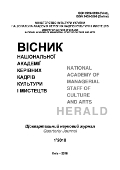HIGH-POSITIONAL SINGING AS A PROBLEM OF VOCAL-CHORAL ACADEMIC PERFORMING
DOI:
https://doi.org/10.32461/2226-3209.1.2018.160498Keywords:
high-positional singing, performing breathing, head resonating, sound generation, singing range, register, articulation, vocal-choral performing.Abstract
The purpose of this scientific article consists in discovering multifaceted significance of high singing position in academic vocal-choral art as well as revealing technological problematic aspects of high positional sound and some ways of its solution for singers of academic performing manner. Methodology of the study is based on the application of theoretical and empirical methods of investigation. The authors use the system-complex technique, which helps to understand the specialized components of high-positional singing as holistic indivisible technological phenomenon of professional vocal-choral academic art. Methods of analysis and synthesis are also used, which allows delineating the most characteristic attributes of high sound position and concentrating on integrity of this vocal skill. The important attention is also given to such empirical techniques as observation and generalization. Scientific novelty of this research lies in the fact that the process of high-positional singing is studied as a separately underlined problem of academic vocal-choral art. Herewith, the high sound position is considered by the investigators from the point of view of technological generalization, productively decisive criterion for complete activity of all musician-singer’s sound generative complex. The authors emphasize the most essential technological role of positional high sound regarding diverse academic voices in high and low registers. Conclusions of the investigative disquisition reflect the main qualitative significance of the high sound position in the academic vocal-choral professional art. The research focuses on the fundamental role of highly professional work of many vocal sound generating components (breathing, resonators and sound attack) for reaching right positional sounding. The researchers denote that qualitative high tone of muscular activity of articulatory sounding apparatus and performing breathing creates resonating foundation in a cavity mouth and pharynx, and involves nasal sinuses, frontal and high-cranial resonating sites. Exactly this generates the conditions for so-called "near" sound.
References
Дмитриев Л.Б. В классе профессора М.Э. Донец-Тессейр (о воспитании лёгких женских голосов) / Л.Б. Дмитриев. – М. : Музыка, 1974. – 64 с.
Коломоєць О.М. Хорознавство: навч. посібник О.М. Коломоєць. – К.: Либідь, 2001. – 168 с.
Никольская-Береговская К.Ф. Русская вокально-хоровая школа ІХ – ХХ веков / К.Ф. Никольская-Береговская. – М. : Языки русской культуры, 1998. – 192 с.
Сикур П.И. Церковное пение. Подготовка дирижеров и регентов к работе с хором / П.И. Сикур. – М. : Русский Хронографъ, 2012. – 496 с.
Сквирский С.И. Вокал и вокруг: педагогические наблюдения / С.И.Сквирский. – К. : Віпол, 2006. – 172 с.
Стасько Г.Є. Голос людини та вокальна робота з ним / Г.Є. Стасько, О.Д. Шуляр. – Івано-Франківськ : Видавництво Прикарпатського національного університету ім. В. Стефаника, 2010. – 336 с.
Стахевич О.Г. Основи вокальної педагогіки. Природно-наукові теорії сольного співу / О.Г. Стахевич. – Харків-Суми : ХДАК-СумДПУ ім. А.С. Макаренка, 2002. – 92 с.
Яковлева А.С. Формирование верхнего участка диапазона мужских голосов / А.С. Яковлева // Вопросы вокальной педагогики. – В. 7. – М. : Музыка, 1984. – С. 73–99.
Dmitriev, L.B. (1974). In the class of Professor M.E. Donetsk-Tesseyr (about the education of women's easy voices). Moskva: Muzyka [in Russian].
Kolomoyets', O.M. (2001). Choir cognition: learning cognition. Kyiv: Lybid' [in Ukrainian].
Nikol'skaja-Beregovskaja, K.F. (1998). Russian vocal choir school of the IX–XX centuries. Moskva: Jazyki russkoj kul'tury [in Russian].
Sikur, P.I. (2012). Church singing Preparation of conductors and reagents for work with chorus. Moskva: Russkij Hronograf [in Russian].
Skvirskij, S.I. (2006). Vocals and around: pedagogical observations. Kiev: Vіpol [in Russian].
Stas'ko, H.Y. & Shulyar, O.D. (2010). Human voice and vocal work with it. Ivano-Frankivs'k: Vydavnytstvo Prykarpats'koho natsional'noho universytetu im. V. Stefanyka [in Ukrainian].
Stahevych, O.G. (2002). Fundamentals of vocal pedagogy. Natural-scientific theories of solo singing. Kharkiv-Sumy`: XDAK-SumDPU im. A.S. Makarenka [in Ukrainian].
Jakovleva, A.S. (1984). Formation of the upper section of the range of male voices. Voprosy vokal'noj pedagogiki, 7, 73–99 [in Russian].
Downloads
Published
Issue
Section
License
Authors who publish with this journal agree to the following terms:
1. Authors retain copyright and grant the journal right of first publication with the work simultaneously licensed under a Creative Commons Attribution License International CC-BY that allows others to share the work with an acknowledgement of the work's authorship and initial publication in this journal.
2. Authors are able to enter into separate, additional contractual arrangements for the non-exclusive distribution of the journal's published version of the work (e.g., post it to an institutional repository or publish it in a book), with an acknowledgement of its initial publication in this journal.
3. Authors are permitted and encouraged to post their work online (e.g., in institutional repositories or on their website) prior to and during the submission process, as it can lead to productive exchanges, as well as earlier and greater citation of published work (See The Effect of Open Access).


